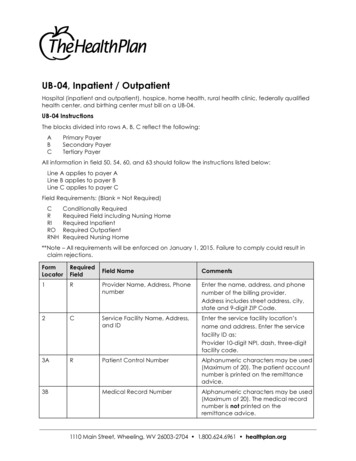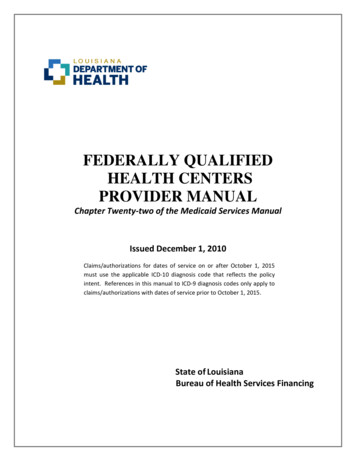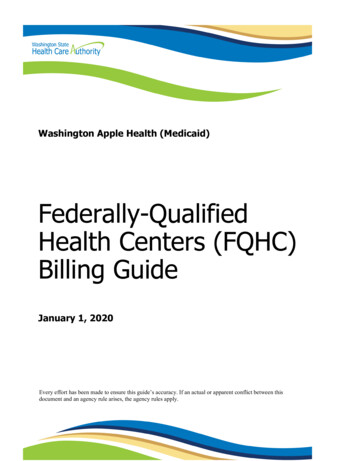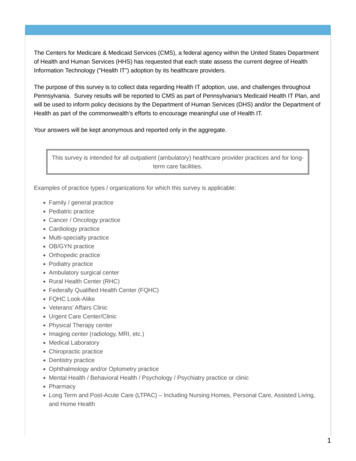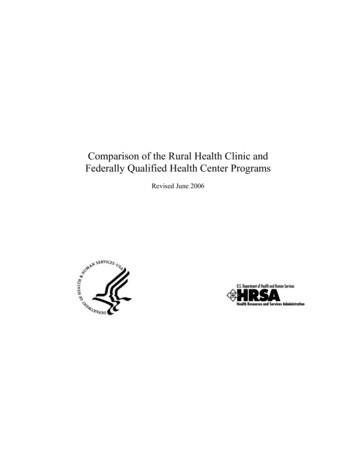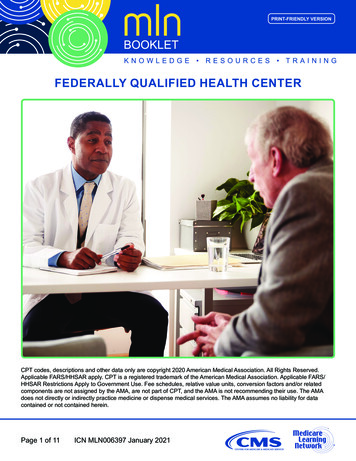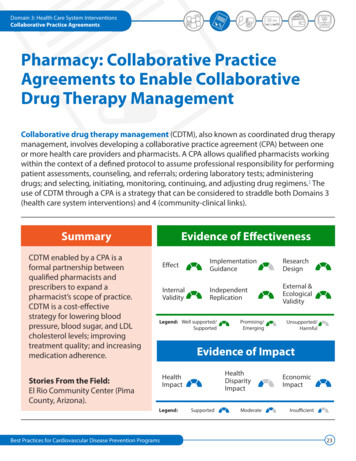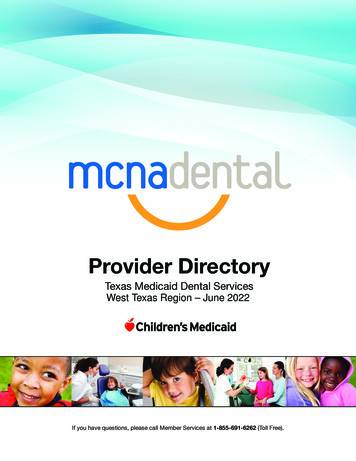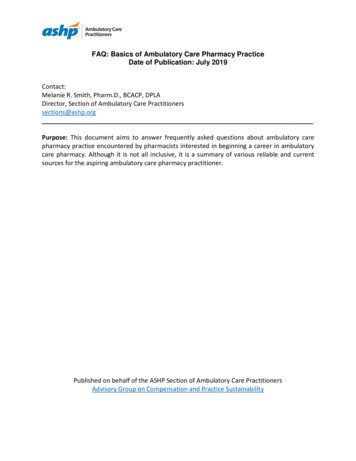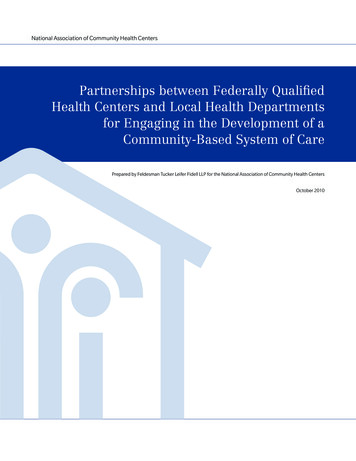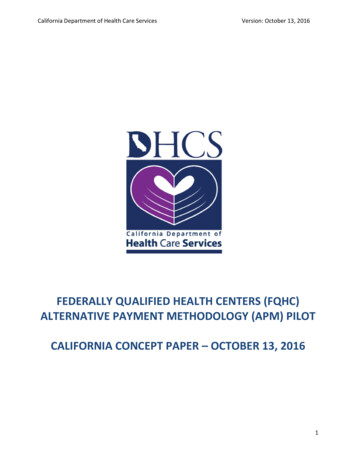
Transcription
California Department of Health Care ServicesVersion: October 13, 2016FEDERALLY QUALIFIED HEALTH CENTERS (FQHC)ALTERNATIVE PAYMENT METHODOLOGY (APM) PILOTCALIFORNIA CONCEPT PAPER – OCTOBER 13, 20161
California Department of Health Care ServicesVersion: October 13, 2016FQHC APM PILOTCALIFORNIA CONCEPT PAPER – OCTOBER 13, 2016TABLE OF CONTENTSI. EXECUTIVE SUMMARY . 3II. INTRODUCTION . 4A. BACKGROUND . 4B. GUIDING PRINCIPLES. 8III. FQHC APM PILOT . 8A. POLICY GOALS . 8B. PILOT OVERVIEW. 9C. PAYMENT STRUCTURE . 10D. CONTRACTING . 11E. RATE DEVELOPMENT . 12F. ENCOUNTERS . 14G. PROPOSED RECONCILIATION . 15H. PROPOSED RISK MITIGATION ON HEALTH PLANS . 16I.PROPOSED PARTICIPATION AND READINESS CRITERIA (CLINICS) . 17J.PROPOSED SELECTION PROCESS (CLINICS) . 18IV. ADDITIONAL PROGRAM ELEMENTS AND TIMELINE . 18A. INDEPENDENT PROGRAM EVALUATION . 18B. STAKEHOLDER ENGAGEMENT . 18C. IMPLEMENTATION PLAN. 19APPENDIX . 202
California Department of Health Care ServicesVersion: October 13, 2016I. EXECUTIVE SUMMARYWith California’s Medicaid program (Medi-Cal) serving nearly 14 million beneficiaries, of whichapproximately 10.5 million are in Medi-Cal managed care health plans, the focus of improving our healthcare delivery system remains top priority. This ongoing commitment to improving the delivery system canbe observed with the recent approval of the State’s Section 1115 Waiver Renewal (Medi-Cal 2020). Whilethis waiver is a significant milestone toward improving our health care delivery system, no specific strategyfor addressing Federally Qualified Health Center (FQHC) payment reform is included in the waiver.FQHCs, including FQHC look-alikes, in California are a core part of the Medi-Cal delivery system. SinceJanuary 1, 2014, Medi-Cal enrollment has grown significantly as result of the Affordable Care Act expandingMedicaid. Coupled with California’s continued efforts in shifting populations into the managed care deliverysystem, these valued safety net providers have absorbed much of the burden to maintain access to primarycare services so that care for beneficiaries is delivered in the most appropriate setting. In recognition oftheir efforts and the changing landscape of health care in California, Department of Health Care Services(DHCS) and much of the stakeholder community supported legislation to implement a delivery system andpayment reform program for FQHCs in California.California State Senate Bill (SB) 147 (Chapter 760, Statutes of 2015) authorized a three-year pilot programfor county and community-based FQHCs, with the goal of incentivizing a delivery system and practicetransformation through the implementation of a new Alternative Payment Methodology (APM). Under theproposed pilot, participating FQHCs will move away from the traditional volume-based payment system toone that better aligns with the evolving financing and delivery of health services.As proposed under the FQHC APM pilot, Medi-Cal managed care plans will receive an actuarially soundsupplemental capitation rate that will incorporate the participating FQHC’s full prospective payment system(PPS) rate. The participating FQHCs in turn will receive for each of their assigned pilot members anactuarially sound clinic-specific capitated payment from the Medi-Cal managed care plan. This clinic-specificcapitated payment will provide the flexibility to deliver care in innovative ways that will expand primary andspecialty care access and help improve the beneficiary experience, while simplifying the payment structurefor these valued safety net providers. By electing to participate in the pilot, FQHCs will no longer have to gothrough multiple billing steps (the plan, the wraparound payment, and the reconciliation). This will simplifythe payment process, alleviating many of the administrative challenges for both the FQHC and the state,while providing FQHCs with the ability to operate more efficiently.This proposed pilot will also help facilitate greater collaboration between our Medi-Cal managed care plansand the FQHCs. While additional requirements will be placed on the Medi-Cal managed care plans and theparticipating FQHCs, both plans and clinics see value in better coordination of care, which will help reduceunnecessary utilization of services in more expensive settings, while also improving beneficiary experience.With a target implementation date set for October 1, 2017, DHCS is looking once again to partner with theCenters for Medicare & Medicaid Services (CMS) in our continued efforts to implement innovativestrategies for coordinating care and payment reform in the Medi-Cal program.3
California Department of Health Care ServicesVersion: October 13, 2016II. INTRODUCTIONThe purpose of this paper is to share the Department of Health Care Services’ (DHCS) proposed concept fora pilot program to implement an alternative payment methodology (APM) for Federally Qualified HealthCenters (FQHCs). This concept paper will provide an overview of the enabling legislation and guidingprinciples, followed by a review of the proposed structure of the APM, and will illustrate DHCS’ robustengagement of the stakeholder community throughout the process to date.A. BACKGROUNDOverview of FQHCs and their requirementsFQHCs were established as a new provider type by Section 4161 of the Omnibus Budget Reconciliation Actof 1990 and became operational beginning October 1, 1991. FQHCs are non-profit or public entities whichreceive a direct grant from the federal government under Section 330 of the Public Health Service Act ormeet the requirements to receive such a grant. Federal law defines the services that can be provided byFQHCs and includes special payment provisions to ensure that they are reimbursed for 100 percent of theirreasonable costs associated with furnishing these services. One of the legislative purposes for doing thiswas to ensure that FQHCs that received Federal Section 330 grant funds were not forced to divert thosegrants to subsidize health center or program services to Medicaid beneficiaries. State Medicaid programsmust pay for all covered services provided by FQHCs.Medicaid (Medi-Cal in California) payments to FQHCs are governed by state and federal law. Section 702 ofthe Medicare, Medicaid, and Benefits Improvement and Protection Act of 2000 (BIPA) added section 1902(bb) to the Social Security Act, changed the FQHC payment methodology from a retrospective cost-basedsystem to a prospective payment system (PPS) methodology. For existing FQHCs, BIPA established a pervisit baseline payment rate equal to 100 percent of the center’s average costs per visit during 1999 and2000. Under PPS, State Medicaid programs are required to pay health centers their PPS per-visit rate foreach face-to-face encounter between a Medicaid beneficiary and one of the FQHC’s billable providers for acovered service. For Medi-Cal managed care members, DHCS is required to reimburse a FQHC for thedifference between its per-visit PPS rate and the payment made by the managed care plan. This payment isknown as a “wrap-around” payment. The managed care wrap-around rate was established to comply withfederal and state regulation to ensure that clinics receive payment for all billable services equal to their PPSrate.FQHCs impact in CaliforniaIn California, there are 1,007 active FQHC service sites, of which 350 are located in rural counties. Theytypically serve California’s vulnerable populations, uninsured, or those eligible for Medi-Cal. Consequently,FQHCs are an integral part of California’s health care safety net. FQHCs provide primary health care services(family medicine, internal medicine, pediatrics, obstetrics and gynecology) that are furnished by physicians,physician assistants, nurse practitioners, nurse midwives, clinical psychologists, licensed clinical socialworkers, comprehensive perinatal practitioners, dental hygienists and dental hygienists in alternativepractice. Services provided at FQHCs may also include: diagnostic lab services, radiologic services,pharmaceutical, preventive health services, appropriate cancer screening, family planning services, andpatient case management. While FQHCs generally provide primary care services for Medi-Cal beneficiaries,a significant portion also provide preventive dental care and behavioral health treatment on site. Thesepreventive services provided by FQHCs help decrease utilization of emergency departments for nonemergency care.4
California Department of Health Care ServicesVersion: October 13, 2016Since January 1, 2014, Medi-Cal enrollment has grown over 35% as a result of the Affordable Care Act(ACA), which expanded Medicaid coverage to previously ineligible persons, primarily childless adults, at orbelow 138 percent of the federal poverty level (FPL). This rapid and significant increase in Medi-Calenrollment has increased demand on the FQHC network to provide access to primary care services formuch of the newly enrolled population. As a result, California has seen the number of clinics increase.Included below is a graph that illustrates the number of FQHCs in California since January 2006.Figure 1: Growth of FQHCs in California since 2006FQHC Service Sites Growth in CaliforniaNumber of Clinics Since s have grown approximately 19% since 2013; however, when compared to the 70% Medi-Calenrollment growth over the same period, the impact on access at FQHCs has been significant. With thesignificant growth of enrollment outpacing the additional facilities each year, the patient coveragedistribution at FQHCs has shifted predominately toward Medi-Cal. In 2014, 60% of the patients at FQHCs inCalifornia were for Medi-Cal beneficiaries, and 39% were enrolled in a Medi-Cal managed care plan (SeeFigure 2 located in the Appendix). As the number of Medi-Cal patients seen by FQHCs grow, it becomesmore important for the provider community to focus on innovation and the delivery of care in the mostappropriate and effective ways—rather than a volume-based payment system that doesn’t incentivize themost appropriate delivery of care.Medi-Cal Enrollment and FQHC Utilization TrendsMedi-Cal beneficiaries receive care through one of two service delivery systems: fee-for-service (FFS) ormanaged care. Under the FFS delivery system, beneficiaries seek medical services from a Medi-Cal providerand the provider bills the Medi-Cal program for each service administered. Under the FFS system,beneficiaries are responsible for locating their own providers. Under Medi-Cal managed care, DHCScontracts with health care plans to administer health care services to Medi-Cal plan members. Thecontracting health plans are paid a monthly payment for each Medi-Cal member and assume the financialrisk for all delegated health care services. Health plans arrange and coordinate care for each memberthrough a defined network of providers, including a vast network of FQHCs.In January 2008, Medi-Cal’s 6.6 million certified eligible beneficiaries were evenly split between the twodelivery systems, with managed care and FFS serving approximately 3.3 million beneficiaries each. But byJanuary 2016, as the overall Medi-Cal program soared to cover roughly 13.5 million Californians, the5
California Department of Health Care ServicesVersion: October 13, 2016proportion of individuals enrolled in managed care grew in tandem. Of all Medi-Cal beneficiaries enrolled asof January 2016, 77% were enrolled in managed care, while only 23% were enrolled in FFS (Figure 3).Certified EligiblesFigure 3: Biannual Trend in Medi-Cal FFS and Managed Care Participation from January 2008-January 112,801,272Month of d CareAs the Medi-Cal population continues to shift into Medi-Cal managed care, the remaining Medi-Cal FFSpopulation largely consists of those individuals entitled to a different or more limited set of benefits ascompared with the scope of services provided by Medi-Cal managed care plans.The populations remaining in FFS today are those with: restricted-scope coverage (due to unsatisfactory immigration status), pregnant women with higher income (138-212% FPL) receiving pregnancy-only coverage, dual eligible beneficiaries, individuals who are determined eligible for Medi-Cal and receive retroactive coverage, individuals temporarily placed in FFS while they wait to receive information materials for enrollinginto Medi-Cal managed care, and the Medically Needy population who has a share-of-cost.Medi-Cal FFS beneficiaries only accounted for 20% of FQHC users and FQHC Visits in 2014. This is notunexpected as Medi-Cal beneficiaries enrolled in FFS tend to either have more intensive medical needs orhave limited scope coverage making FQHCs less than other service settings.ACA ImplementationBetween January 2014 and the end of 2015, nearly 3.5 million adult beneficiaries enrolled in Medi-Calthrough ACA implementation, accounting for approximately 26% of the overall Medi-Cal population.This dramatic increase in the Medi-Cal population had a direct correlation to the utilization observed at theFQHCs. As illustrated below in Figure 4, California’s FQHCs experienced on average 5-8% annual growth inthe number of visits between 2009 and 2013. However, as result of the ACA, the change in total number ofvisits between 2013 and 2014 represented over a 44% increase.6
California Department of Health Care ServicesVersion: October 13, 2016Figure 4: Medi-Cal FQHC Utilization Trends, 2008-2014Year2008200920102011201220132014Medi-Cal FQHC Utilization Trends, 2008-2014# of Beneficiariesenrolled atNumber of UniqueNumber of Visitsleast oneUsersmonth in ts Per User4.44.44.34.34.44.14.2Not only has the overall number of visits significantly increased in recent years, but also as Medi-Calcontinues to shift to managed care, the proportion of Medi-Cal managed care members receiving servicesat the FQHCs has as well.Analysis of the current billing process (initial payment, wraparound, reconciliation)Existing law requires FQHCs to be reimbursed on a per-visit basis. For each billable visit, FQHCs are paid aPPS rate. Currently, if a Medi-Cal managed care member visits a FQHC for a billable service, the planreimburses the FQHC a capitated or FFS payment no less than an amount that the plan would make for thesame service furnished by a provider that is not an FQHC. If this payment is less than the PPS rate, the FQHCthen invoices DHCS and receives an interim wrap-around payment. If the interim wrap-around payment isdifferent than the PPS rate, DHCS will issue a payment or recoupment later after a reconciliation isconducted. Included below is an illustration of the current payment structure assuming the wrap-aroundpayment did not adequately cover the PPS rate.Figure 5: Current FQHC Payment Flow for a Medi-Cal managed care member7
California Department of Health Care ServicesVersion: October 13, 2016Why an Alternative Payment Method (APM)?California views the APM as an opportunity to incentivize delivery system reform and practicetransformation for clinics to deliver care in more effective ways without jeopardizing the sustainablefunding levels afforded to these entities. The proposed pilot payment structure, as further detailed in thenext section, will provide FQHCs with greater flexibility for meeting patient care needs, help reduce theunnecessary utilization of services, and improve the overall beneficiary experience.Even though the number of FQHCs has grown by 19% since 2013, the additional number of visits coupledwith the significant increase in the number of Medi-Cal managed care members has created a higherdemand for primary care services. In order to accommodate the increased demand for services, clinicstoday are focused on expanding access through delivering care in more effective and appropriate methods.These methods do not always align with the current payment structure. This unfortunately does notincentivize the transformation efforts and creates additional challenges in the decision making process forclinics when identifying which services they are will to provide without reimbursement.B. GUIDING PRINCIPLESDHCS ObjectivesAs part of the backbone of California’s health care safety net,DHCS is committed to preserving and improving the overallhealth and well-being of all Californians. In order to meet thehealth care needs of the state, DHCS continues ourcommitment to achieving the Triple Aim—better care, betterhealth, and lower costs.DHCS experience with Delivery System Reform and APMsCalifornia’s commitment to improving quality and better integrating care through APMs is not a newconcept. Rather than paying for services via a FFS delivery system, DHCS has participated in risk-basedcontracts with managed care plans for several decades. Medi-Cal managed care has grown recently withthe expansion of managed care statewide in 2012 and the gradual movement of Medi-Cal populations intomanaged care. Today, with over 10.5 million beneficiaries in managed care, Medi-Cal managed care is atrue testament to providing high quality, accessible, and cost-effective health care. In addition tooverseeing an extensive managed care delivery system, DHCS has experience with implementing otherdelivery system and payment transformation efforts that are currently in effect today.III. FQHC APM PILOTA. POLICY GOALSAs California continues to be a leader in the implementation of the Affordable Care Act with the expansionof over 3.5 million beneficiaries, the Medi-Cal program becomes ever more reliant on our primary careprovider network for continuing our commitment to improving quality and better integrating care. Asillustrated in the background section, one of Medi-Cal’s most important group of primary care providers isour vast network of FQHCs. These clinics provide value to the overall delivery system in access, quality ofcare, and help minimize the total cost of care. DHCS understands the value of the FQHC network and therecent implications expanding Medi-Cal enrollment has played on their operations.8
California Department of Health Care ServicesVersion: October 13, 2016Through extensive collaboration with the California Primary Care Association (CPCA) and CaliforniaAssociation of Public Hospitals and Health Systems (CAPH), who combined represent over 1,000 communityclinics and FQHCs, DHCS has established several core policy goals to guide design and implementation ofthe proposed APM pilot program.I.II.III.IV.V.Transition from the volume-based (PPS) system to one that better aligns financing and delivery ofhealth services;Promote care delivery redesign and allow for flexibility to deliver care in the most effective ways toimprove primary care access;Improve the beneficiary experience;Enhance collaboration and coordination between FQHCs and Medi-Cal managed care plans.Simplify the payment structure for clinics and shift the primary payor responsibility to the Medi-Calmanaged care plans;B. PILOT OVERVIEWCalifornia State Senate Bill (SB) 147 (Chapter 760, Statutes of 2015) authorized a three-year APM pilotprogram for county and community-based FQHCs willing to participate in the pilot program. SB 147’spurpose is to incentivize delivery system and practice transformation at FQHCs through flexibilitiesavailable under a capitated model which would move the clinics away from the traditional volume-based,PPS, to a payment methodology that better aligns the evolving financing and delivery of health services.The proposed APM structure provides participating FQHCs the flexibility to deliver care in the mosteffective manner, without having to worry about the more restrictive traditional billing structure that is inplace today. With the flexibility of payment reform, FQHCs will begin to provide and/or expand upon theinnovative forms of care which are not reimbursed under traditional volume-based PPS. Examples of nontraditional services could include but are not limited to: integrated primary and behavioral health visits onthe same day, group visits, email visits, phone visits, community health worker contacts, case management,and care coordination across systems.Under the proposed APM pilot, for beneficiaries who are assigned to a FQHC as their primary care provider,the direct payor for full FQHC payment would transition from the state to Medi-Cal managed care plans.The clinic-specific capitated payment methodology would ensure participating clinics are reimbursed at noless than the PPS rate, as prescribed under federal law, while incentivizing delivery system reform andpractice transformation at FQHCs through funding flexibilities available under a full capitation paymentstructure. Participating clinics will be able to promote more cost-effective and higher value care to theirassigned pilot members. This structure will reward the provision of care via more appropriate methods thatwill improve the beneficiary’s experience while also improving access for beneficiaries who may not accessprimary care services on a regular basis. This is especially true for those beneficiaries residing in rural areas,where long distances and provider shortages are common barriers to care.By virtue of implementing a capitated model, the pilot is also structured to allow for more administrativeflexibility for the clinics. For those assigned members, clinics will no longer need to submit claims for wraparound payments to the state and wait years for a reconciliation to PPS to occur. The simplicity of receivinga capitation from the Medi-Cal managed care plans directly each month for their assigned pilot members,will provide a more expeditious reimbursement to the clinics. The response so far from the clinics to thisproposed structure has been positive as they believe this will help alleviate cash flow implications andadministrative challenges regarding the lengthy process to receive full reimbursement to PPS.Pursuant to the provisions within SB 147, DHCS will invite all FQHCs (including FQHC look-alikes) toparticipate in the proposed APM pilot. There will be a formal application period for those clinics who areinterested to apply and DHCS will make the final determination as to whether a clinic will participate in the9
California Department of Health Care ServicesVersion: October 13, 2016proposed pilot, using a robust set of criteria. While it is optional for FQHCs to apply and to participate ifselected, Medi-Cal managed care plans will be required to amend their contracts with participating networkclinics to incorporate the specific provisions and requirements of the proposed APM pilot.Given that there are unknowns when switching to new payment methodologies there are several riskmitigation elements incorporated into the structure of the pilot. On the plan side, the use of supplementalcapitation assists in mitigating the risk of the number of members actually assigned to pilot clinics andadditionally there are risk corridors included in the structure of the supplemental capitations which willhelp alleviate risk for the Medi-Cal managed care plans. Secondly, there are triggers in place for the FQHCs,in the event traditional visit utilization of the assigned pilot members is above/below certain levels ascompared to the expected utilization in the absence of the pilot in order to ensure compliance with thePPS-level reimbursement.DHCS has an implementation target date of October 1, 2017, for the proposed pilot.C. PAYMENT STRUCTUREProposed payment structureUnder the proposed APM pilot, DHCS would be responsible for calculating an actuarially sound health planspecific supplemental capitation payment and a clinic-specific per-member-per-month (PMPM) paymentfor each category of aid included in the pilot target population. The Medi-Cal managed care plansupplemental capitation payment will be paid to each health plan on a monthly basis for the assigned pilotmembers. Health plans would then be responsible for paying each participating FQHC payments equivalentto that clinic’s specific PMPM rate (also calculated by DHCS) for members who are assigned to the clinic astheir primary care provider.The FQHC clinic-specific PMPM payment will initially be based on historical utilization for those assignedpilot members and will be projected at the equivalent level of PPS funding. In exchange for the capitatedPMPM payments, the clinic would be responsible for all services required by the beneficiary that are withinthe clinic’s scope of services.The capitated payments will provide greater flexibility in health care delivery for the FQHC by enabling theFQHC to provide different types of health care services without having to meet the per-visit billingrequirement to generate Medi-Cal revenue. Included below is an illustration of the proposed APMpayment:Figure 6: Proposed FQHC APM pilot payment flow10
California Department of Health Care ServicesVersion: October 13, 2016Comparison of proposed payment structure to the current payment structureToday as established in the existing payment structure, DHCS is responsible for reimbursing a FQHC for thedifference between its per-visit PPS rate and the payment made by the plan. It depends on how quickly theclinic can submit an invoice to DHCS for the wrap-around payment, but it’s highly unlikely the clinic willreceive a payment in the same month that services are rendered. After the wrap-around payment occurs,as required by federal and state law, DHCS then is required to reconcile each visit with the PPS rate. Due tothe overwhelming amount of visits rendered at FQHCs each year, there is over a two-year timeframe forreconciliations to occur. Each reconciliation can yield two possibilities: the clinic wrap around payment waseither greater or less than their PPS. In the event the received less than their PPS rate, DHCS would issue areconciliation payment to the clinics. If that wrap-around payment was more than their PPS rate, DHCSwould recoup the overpayment from the clinics, which can create a cash flow issue in future years forclinics.As illustrated above in Figure 6, the proposed APM pilot payment flow is designed to shift the primarypayor responsibility for the full FQHC PPS payment from DHCS to the Medi-Cal managed care plan. Thisshift allows for a more expeditious payment to the participating FQHCs for those assigned pilot members.The Medi-Cal managed care plans will be required via their contract, to pay clinics each and every monththe clinic-specific PMPM payments (calculated by DHCS) for the assigned pilot members. This should be asclose to real-time as possible—for which the stakeholder community has expressed their support. Theirinterest in this modification to payment is understandable when comparing the proposed structure to thetraditional process where clinics can wait years before receiving full reimbursement or having to repayDHCS for overpayments.D. CONTRACTINGState and Managed Care PlanAs structured in the proposed pilot, Medi-Cal managed care plans will become the primary payor for fullFQHC payment for those assigned pilot members. This will require a modification in the existing contractsbetween the Medi-Cal managed care plan and DHCS, which will make th
visit baseline payment rate equal to 100 percent of the center's average costs per visit during 1999 and 2000. Under PPS, State Medicaid programs are required to pay health centers their PPS per-visit rate for each face-to-face encounter between a Medicaid beneficiary and one of the FQH's billable providers for a covered service.
